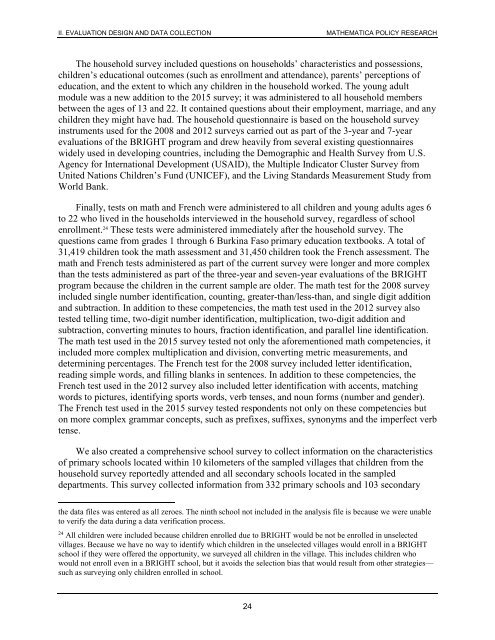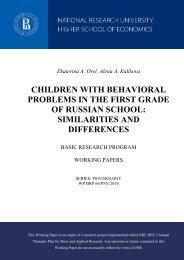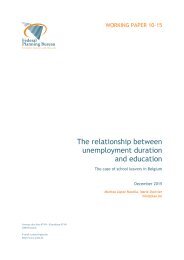Ten-Year Impacts of Burkina Faso’s BRIGHT Program
n?u=RePEc:mpr:mprres:2ecdd42bb503422b802ce20da2bf64b7&r=edu
n?u=RePEc:mpr:mprres:2ecdd42bb503422b802ce20da2bf64b7&r=edu
Create successful ePaper yourself
Turn your PDF publications into a flip-book with our unique Google optimized e-Paper software.
II. EVALUATION DESIGN AND DATA COLLECTION<br />
MATHEMATICA POLICY RESEARCH<br />
The household survey included questions on households’ characteristics and possessions,<br />
children’s educational outcomes (such as enrollment and attendance), parents’ perceptions <strong>of</strong><br />
education, and the extent to which any children in the household worked. The young adult<br />
module was a new addition to the 2015 survey; it was administered to all household members<br />
between the ages <strong>of</strong> 13 and 22. It contained questions about their employment, marriage, and any<br />
children they might have had. The household questionnaire is based on the household survey<br />
instruments used for the 2008 and 2012 surveys carried out as part <strong>of</strong> the 3-year and 7-year<br />
evaluations <strong>of</strong> the <strong>BRIGHT</strong> program and drew heavily from several existing questionnaires<br />
widely used in developing countries, including the Demographic and Health Survey from U.S.<br />
Agency for International Development (USAID), the Multiple Indicator Cluster Survey from<br />
United Nations Children’s Fund (UNICEF), and the Living Standards Measurement Study from<br />
World Bank.<br />
Finally, tests on math and French were administered to all children and young adults ages 6<br />
to 22 who lived in the households interviewed in the household survey, regardless <strong>of</strong> school<br />
enrollment. 24 These tests were administered immediately after the household survey. The<br />
questions came from grades 1 through 6 <strong>Burkina</strong> Faso primary education textbooks. A total <strong>of</strong><br />
31,419 children took the math assessment and 31,450 children took the French assessment. The<br />
math and French tests administered as part <strong>of</strong> the current survey were longer and more complex<br />
than the tests administered as part <strong>of</strong> the three-year and seven-year evaluations <strong>of</strong> the <strong>BRIGHT</strong><br />
program because the children in the current sample are older. The math test for the 2008 survey<br />
included single number identification, counting, greater-than/less-than, and single digit addition<br />
and subtraction. In addition to these competencies, the math test used in the 2012 survey also<br />
tested telling time, two-digit number identification, multiplication, two-digit addition and<br />
subtraction, converting minutes to hours, fraction identification, and parallel line identification.<br />
The math test used in the 2015 survey tested not only the aforementioned math competencies, it<br />
included more complex multiplication and division, converting metric measurements, and<br />
determining percentages. The French test for the 2008 survey included letter identification,<br />
reading simple words, and filling blanks in sentences. In addition to these competencies, the<br />
French test used in the 2012 survey also included letter identification with accents, matching<br />
words to pictures, identifying sports words, verb tenses, and noun forms (number and gender).<br />
The French test used in the 2015 survey tested respondents not only on these competencies but<br />
on more complex grammar concepts, such as prefixes, suffixes, synonyms and the imperfect verb<br />
tense.<br />
We also created a comprehensive school survey to collect information on the characteristics<br />
<strong>of</strong> primary schools located within 10 kilometers <strong>of</strong> the sampled villages that children from the<br />
household survey reportedly attended and all secondary schools located in the sampled<br />
departments. This survey collected information from 332 primary schools and 103 secondary<br />
the data files was entered as all zeroes. The ninth school not included in the analysis file is because we were unable<br />
to verify the data during a data verification process.<br />
24<br />
All children were included because children enrolled due to <strong>BRIGHT</strong> would be not be enrolled in unselected<br />
villages. Because we have no way to identify which children in the unselected villages would enroll in a <strong>BRIGHT</strong><br />
school if they were <strong>of</strong>fered the opportunity, we surveyed all children in the village. This includes children who<br />
would not enroll even in a <strong>BRIGHT</strong> school, but it avoids the selection bias that would result from other strategies—<br />
such as surveying only children enrolled in school.<br />
24







